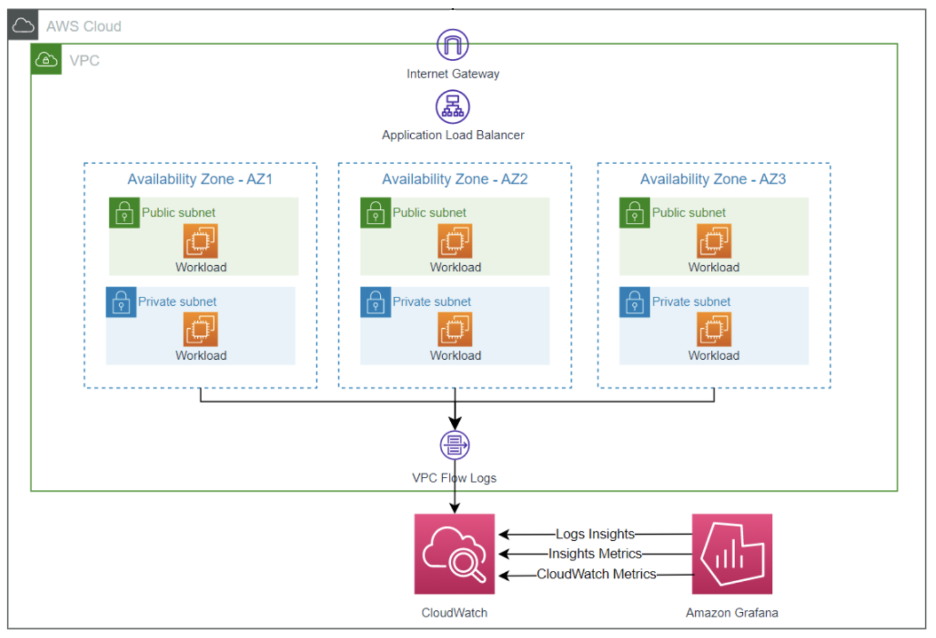ネットワークオブザーバビリティのための VPC フローログ
最新のクラウド環境では、ネットワークオブザーバビリティはアプリケーションとインフラストラクチャのセキュリティ、パフォーマンス、信頼性を確保する上で重要な役割を果たします。Amazon Web Services (AWS) が提供する機能である Amazon Virtual Private Cloud (VPC) フローログは、VPC 内のネットワークトラフィックの可視性を確保し、効果的なトラブルシューティングとセキュリティ分析を可能にする強力なツールです。
VPC フローログは、VPC 内外の IP トラフィックに関するメタデータを取得し、ネットワーク通信パターン、潜在的なセキュリティ脅威、パフォーマンスのボトルネックに関する貴重な洞察を提供します。VPC フローログを活用することで、組織は以下のメリットを得ることができます:
-
ネットワークトラフィックの可視性: VPC フローログは、送信元と宛先の IP アドレス、ポート、プロトコル、パケットサイズ、フローの方向など、ネットワークトラフィックに関する�詳細な情報を記録します。このネットワークトラフィックパターンの包括的な可視性により、組織は異常を特定し、潜在的なセキュリティ脅威を検出し、ネットワーク構成を最適化することができます。
-
セキュリティ監視と脅威検出: VPC フローログを分析することで、セキュリティチームは不正アクセスの試み、ポートスキャン、データ流出の試みなどの不審な活動をモニタリングできます。このプロアクティブな監視アプローチにより、組織は潜在的なセキュリティ脅威をより効果的に検出し対応することができます。
-
コンプライアンスと監査: VPC フローログは、ネットワークトラフィックの詳細な監査証跡を提供し、組織がコンプライアンス要件を満たし、セキュリティポリシーや業界規制への準拠を示すことを可能にします。この監査証跡は、フォレンジック調査やインシデント対応の取り組みにも役立ちます。
-
アプリケーションパフォーマンスのトラブルシューティング: ネットワークのボトルネックや接続の問題は、アプリケーションのパフォーマンスに大きな影響を与える可能性があります。VPC フローログを使用することで、組織はトラフィックパターンを分析し、潜在的なボトルネックを特定し、それに応じてネットワーク構成を最適化することで、ネットワーク関連のパフォーマンスの問題を特定し、トラブルシューティングを行うことができます。
-
コスト最適化: VPC フローログを分析することで、組織はネットワークトラフィックパターンとリソース使用率に関す��る洞察を得ることができます。この情報を使用して、ネットワーク構成を最適化し、ネットワークリソースのサイズを適切に調整し、過剰なプロビジョニングや未使用リソースに関連する不要なコストを削減する可能性があります。
 図 1: Grafana による VPC フローログの可視化
図 1: Grafana による VPC フローログの可視化
ネットワークオブザーバビリティとトラブルシューティングのために VPC フローログを活用するには、組織は以下の一般的な手順に従うことができます:
-
VPC フローログの有効化: VPC または VPC 内の特定のネットワークインターフェースに対して VPC フローログを設定し、目的のログ送信先(Amazon CloudWatch Logs、Amazon S3、またはサードパーティのログ管理ソリューションなど)を指定します。
-
ログデータの分析: ログ分析ツールやカスタムスクリプトを使用して VPC フローログデータを解析し、記録されたネットワークトラフィック情報に基づいてパターン、異常、または潜在的なセキュリティ脅威を特定します。
-
セキュリティおよび監視ツールとの統合: VPC フローログデータを既存のセキュリティおよび監視ソリューション(Security Information and Event Management (SIEM) システムなど)に組み込み、ネットワークトラフィックデータを他のセキュリティイベントやアラートと相関させます。
-
アラートと通知の設定: VPC フローログで検出された特定のパターンやしきい値に基づいてアラートと通知を設定し、潜在的なセキュリティ脅威やパフォーマンスの問題に対してプロアクティブな対応を可能にします。
-
ネットワーク構成の最適化: VPC フローログからの洞察を活用して、ネットワーク構成を最適化し、セキュリティグループルールを微調整し、ネットワークパフォーマンスとセキュリティ態勢を向上させるためのトラフィックシェーピングやフィルタリングメカニズムを実装します。
VPC フローログは貴重なネットワークオブザーバビリティとトラブルシューティング機能を提供しますが、ログデータの量とコスト管理などの潜在的な課題を考慮することが重要です。ネットワークトラフィックの量が増加するにつれて、生成されるログデータの量も大幅に増加する可能性があり、ストレージコストとパフォーマンスに影響を与える可能性があります。効率的でコスト効果の高いログソリューションを確保するために、ログデータ保持ポリシー、サンプリング戦略、コスト最適化テクニックの実装が必要になる場合があります。
さらに、VPC フローログへの適切なアクセス制御とデータセキュリティの確保が重要です。AWS は、ログデータの機密性と整合性を保護するための詳細なアクセス制御メカニズムと暗号化機能を提供しています。
結論として、VPC フローログは AWS 環境でネットワークオブザーバビリティを実現し、効果的なトラブルシューティングを可能にする強力なツールです。ネットワークトラフィックパターンに関する詳細な洞察を提供することで、VPC フローログは組織がセキュリティ脅威�を監視し、ネットワーク構成を最適化し、パフォーマンスの問題をトラブルシューティングし、コンプライアンスを維持することを可能にします。VPC フローログを既存のセキュリティおよび監視ソリューションに統合することで、組織は全体的なオブザーバビリティを向上させ、安全で高性能かつ信頼性の高いクラウドインフラストラクチャを維持することができます。